It pains me to have to write a blog on this topic in 2019. I feel that at this point, people who claim they haven’t seen enough evidence that humans are changing the climate are, frankly, just not looking very hard. Plenty of people have covered this topic in the past and there are some great summaries available, at all different levels of scientific detail.
Nevertheless, this is a question I’ve found myself being asked to address repeatedly over the last few weeks and months. So I thought I would just write down my answer here instead.
So, what is the evidence that the climate is changing?
There are five key pieces of evidence that the climate is changing more rapidly and more dramatically than the Earth has seen in millennia:
- The levels of greenhouse gases such as carbon dioxide (CO2), methane (CH4) and nitrous oxide (N2O) in the atmosphere have increased rapidly since the beginning of the industrial revolution. We know this from direct measurements at the Mauna Loa Observatory in Hawaii, where atmospheric CO2 has increased from 313 parts per million (ppm) in March 1958 to 411.97 ppm in March 2019.
- Longer-term records show that concentrations of greenhouse gases have not been this high in at least 800,000 years. They haven’t risen this rapidly for at least 22,000 years. We know this from measurements of the carbon trapped in ice cores from Antarctica.
- At the same time, we have measured warming of the air, land and sea at observatories and weather stations worldwide. The average global temperature has risen by 0.87°C since 1850 – the warmest the Earth has been in 7,000 years. We know this from analysing more than 70 different measures of global temperature, including tree rings, lake and ocean sediments, stalactites (and stalagmites), and ice cores.
- The rate of warming we have measured is exceptional in Earth’s climate history. The land and oceans warmed by 0.17°C per decade between 1981 and 2018 – the fastest warming in 1,500 – 2,000. We know this from analysing over 300 independent estimates of global temperature.
- Laboratory experiments proved in the 19th Century that greenhouse gases absorb heat. Satellite measurements have shown that these particles behave the same way up there, trapping heat in the lower atmosphere and warming the planet.
Together, those five lines of evidence should be enough to convince you that climate change is not only real, but driven by human activities. Just in case you’re not convinced, let’s dive into the science in a bit more detail.
The Greenhouse Effect
The heat-trapping effect of greenhouse gases is massive, and has been known for centuries. Greenhouse gases absorb some of the sun’s energy and re-emit it into the lower atmosphere. Carbon dioxide is probably the most famous, but water vapour and methane actually have a much stronger greenhouse effect.
American scientist Eunice Newton Foote first hypothesised that carbon dioxide in the atmosphere affects global temperature back in 1856. Calculations by Swedish scientist Svante Arrhenius showed that human greenhouse gas emissions could be enough to alter the climate, and we can now observe heat being trapped by the atmosphere with satellites.
Without the greenhouse gases that make up our atmosphere, the Earth would be a chilly -18 C.
Animation by NASA Global Climate Change
The Carbon Cycle
The Earth has a natural carbon cycle that, in isolation, would result in relatively constant levels of atmospheric CO2. Plants absorb CO2 from the air to fuel photosynthesis and either store the carbon in their tissues, or release it into the soil. Animals in turn eat the plants and use the carbon to fuel their growth. When these plants, animals and microbes die, their carbon is released back into the atmosphere, completing the cycle.
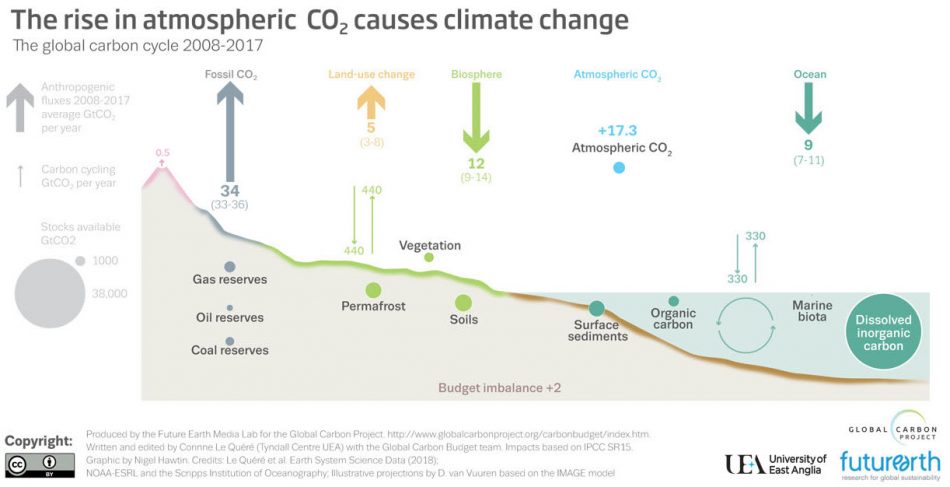
Infographic by the Global Carbon Project used under a creative commons license
The carbon cycle varies annually because plants photosynthesise more (and absorb more CO2) in the summer. There are far more plants in the Northern Hemisphere than in the southern hemisphere, so global atmospheric CO2 levels track the annual ebb and flow of the northern-hemisphere carbon cycle. But zooming out from that annual variation, there is a clear trend, which American scientist Charles David Keeling first reported in 1960.
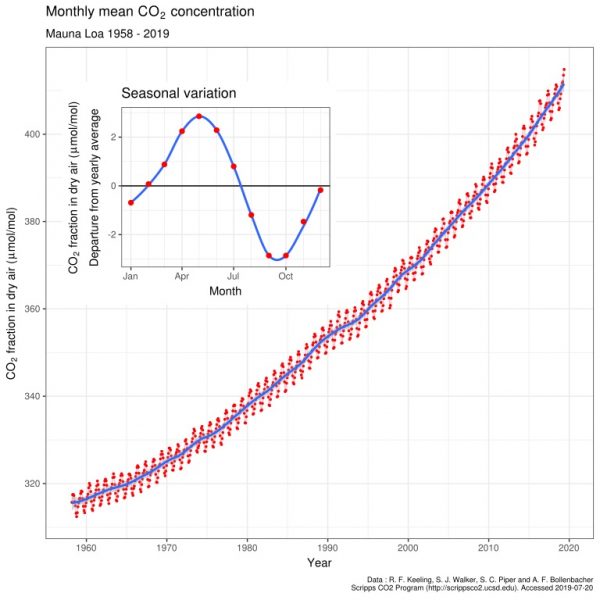
Graph created by Delorm using data from Dr. Pieter Tans, NOAA/ESRL and Dr. Ralph Keeling, Scripps Institution of Oceanography. Image used under a creative commons license from Wikipedia.
How do we know?
Direct measurements of air trapped in ice cores tell us that the atmospheric CO2 levels haven’t been this high in at least 800,000 years. Before that, scientists have been able to make estimates by looking at the chemical composition of shells from tiny marine organisms known as Foraminifera, which stretch back 20 million years. These calculations show that atmospheric CO2 levels haven’t been this high for between 15 and 20 million years.
For perspective, back in the Middle Miocene (around 16 million years ago) when CO2 levels were around present-day levels, the temperature was 3°C – 6°C warmer and the seas were 25 – 45 metres higher than today.
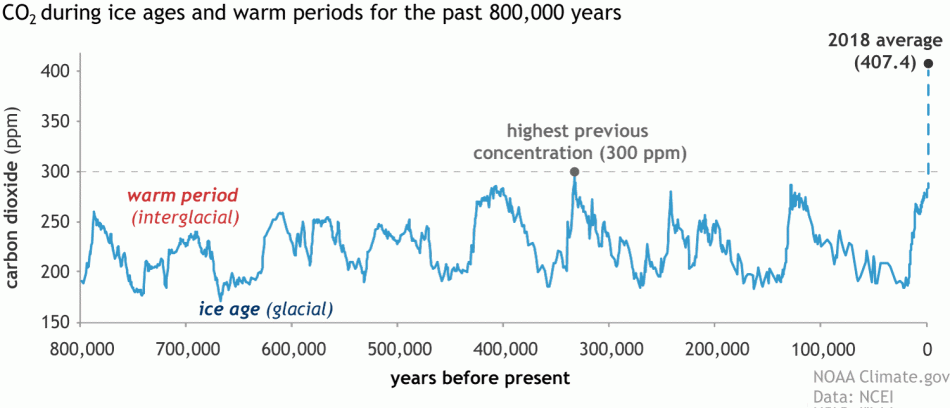
Figure from Climate.gov is in the public domain.
We passed the 400 ppm milestone in 2013, and there are reports that just six years later, we are close to exceeding 415 ppm. In May 2019 Mauna Loa recorded 414.7 ppm, the highest seasonal peak in 61 years of observations, leaping 3.5 ppm from the previous year.
On the day of publishing, the concentration of CO2 in the atmosphere was 408.7 ppm, 58 ppm higher than in 1987, the year I was born.
A warming planet
The global temperature closely tracks the levels of CO2 in the atmosphere and has done for Millenia. We know this by comparing temperature and CO2 estimates made from ocean and lake sediments, ice cores, tree rings, marine creatures and many other sources of evidence. Detailed comparisons have shown that throughout the Pleistocene Ice ages, temperature increases were always preceded by an increase in atmospheric CO2.
As the atmospheric CO2 levels have risen over the past century, we have seen hotter and hotter global temperatures. The period from 1983 to 2012 was the warmest 30-year period in the Northern Hemisphere in the last 1400 years. The last five years have been the five warmest years on record, and in August 2016 the average global land and ocean surface temperature hit +0.98°C above the 20th Century average.
Since the mid-20th century, the lower atmosphere has warmed while the upper atmosphere has cooled. This is the hallmark of greenhouse-gas induced climate warming, because the cooling upper atmosphere shows that less heat is escaping back into space.
It’s not a perfectly linear warming trend (this is nature, why would we expect it to be?) there is some variability in the system caused by natural fluctuations of solar radiation, planetary orbit, and El Niño .
The world also hasn’t warmed evenly. For example, the poles – where climate feedbacks from melting ice are most immediate – are warming faster than the tropics. Air surface temperatures have also increased faster on land than at sea – the global average has risen 0.87°C since 1850, but the average land surface air temperature has increased by 1.53°C.
According to the 2014 IPCC Report on Climate Change:
“Warming of the climate system is unequivocal, and since the 1950s, many of the observed changes are unprecedented over decades to millennia. The atmosphere and ocean have warmed, the amounts of snow and ice have diminished, and sea level has risen“
Intergovernmental Panel on Climate Change (IPCC) 2014 – AR5 Climate Synthesis Report for Policy Makers
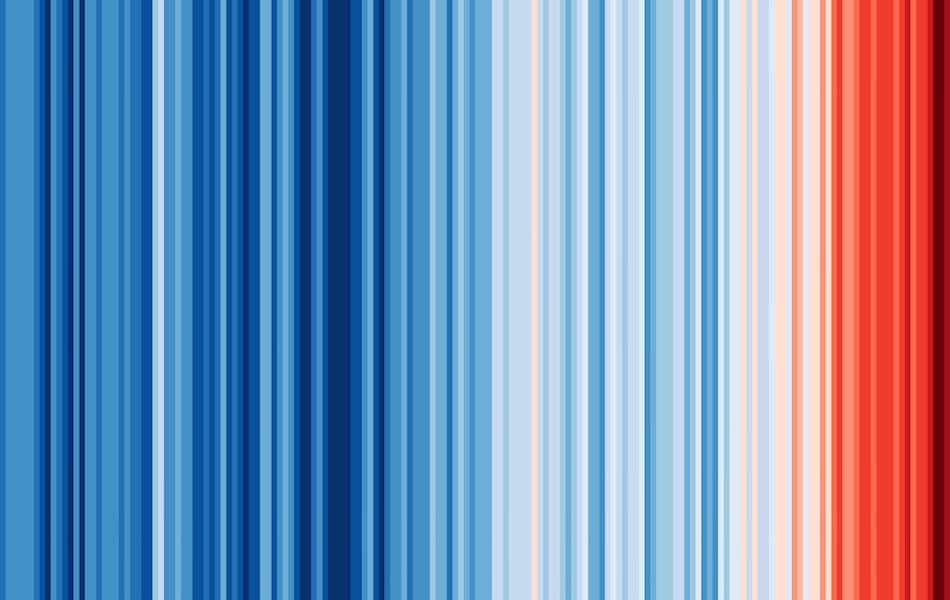
Image used under a creative commons license from Climate Lab Book.
Knock-on effects of climate change
There is also plenty of evidence that the temperature increases we have measured are having a real impact on the Earth’s climate and weather systems. For example, we’ve measured significant reductions in the amount of snowfall, and the extent of sea ice, glaciers and permafrost.
As a result of all that melting ice, sea levels have risen at least 0.16 meters since 1902. Sea level has risen faster since the mid-19th century than at any time in the last 2,000 years. Most of the sea level rise so far has been driven by melting glaciers and ice sheets and the physical expansion of water as it warms.
- Between 1979 and 2012 the Arctic sea ice retreated by at least 3.5% per decade.
- Snow cover in the Arctic circle declined by 13.4% per decade between 1967 an 2018, totalling 2.5 million square kilometres of land.
- Between 2006 and 2015, the Greenland ice sheet lost an average of 278 gigatonnes of ice per year.
- Surface melting was observed in Greenland in 2012. This rare phenomenon has not been seen in the geological record since the Eemian period, around 130,000 years go, when Greenland was about 8°C warmer than today and the sea level was 4 – 8 metres higher.
- The loss of ice from the Antarctic ice sheet between 2007 and 2016 was triple that of the previous decade.
We have also seen an increase in ocean acidity as the waters absorb CO2 from the atmosphere. The global ocean pH has decreased by 0.1 – a 26% increase in acidity, since the beginning of the industrial era.
Not to mention that there has been an increase in extreme weather events, which is expected as the climate warms, because there is more energy and moisture in the atmosphere and oceans. Floods, droughts and hurricanes have all increased in prevalence over the last century.
How do we know humans are causing it?
Humans have fundamentally changed the carbon cycle by burning carbon stored in fossil fuels, and by cutting down trees. Carbon stores built up over millennia have been combusted and returned to the air in a less than 200 years.
Prior to human intervention, global atmospheric CO2 levels had been gradually declining over the last 450 million years, albeit at the crawling rate of 13 ppm per million years.
Since the beginning of the industrial revolution, when humans began burning fossil fuels on, well an industrial scale, we have released an estimated 2040 gigatons of CO2, about 40% of which is still in the atmosphere today.
The other 60% has been absorbed by our oceans, forests and soils. The ocean has absorbed about 30% of all human carbon emissions, which has lead to acidification and bleached corals around the world.
Our emissions are accelerating
Greenhouse gas emissions have increased since 1970 and the rate is continuing to accelerate. About half of all the carbon humans have emitted into the atmosphere since the industrial revolution has happened in the last 40 years.
Increases in greenhouse gas emissions are primarily being driven by energy, industrial processes, and transport. Between 1970 and 2011, CO2 emissions from fossil fuels and cement production tripled. Meanwhile emissions from forestry and land-use change increasing 40%. As a result, carbon dioxide is being released into the atmosphere at the fastest rate in 66 million years.
Deforestation is a triple-whammy for climate change
Deforestation has a triple effect on the climate because in the short-term it releases large amounts of carbon into the atmosphere that was stored in the wood, stems and leaves; in the medium-term the exposed soil often erodes releasing more stored carbon back into the atmosphere; and in the long-term it reduces the amount of CO2 being absorbed to fuel plant growth. In fact, after burning fossil fuels and industrial processes, agriculture and forestry are together responsible for the next biggest share (23%) of the greenhouse gas emissions.
It’s not all about carbon dioxide
Although CO2 represents the lion’s share of our greenhouse gas emissions, methane is four-times more potent at warming the planet, and we are releasing a significant amount of that, too. The biggest sources of methane come from agriculture, waste and fossil fuels, although forest fires and flooding also contribute.
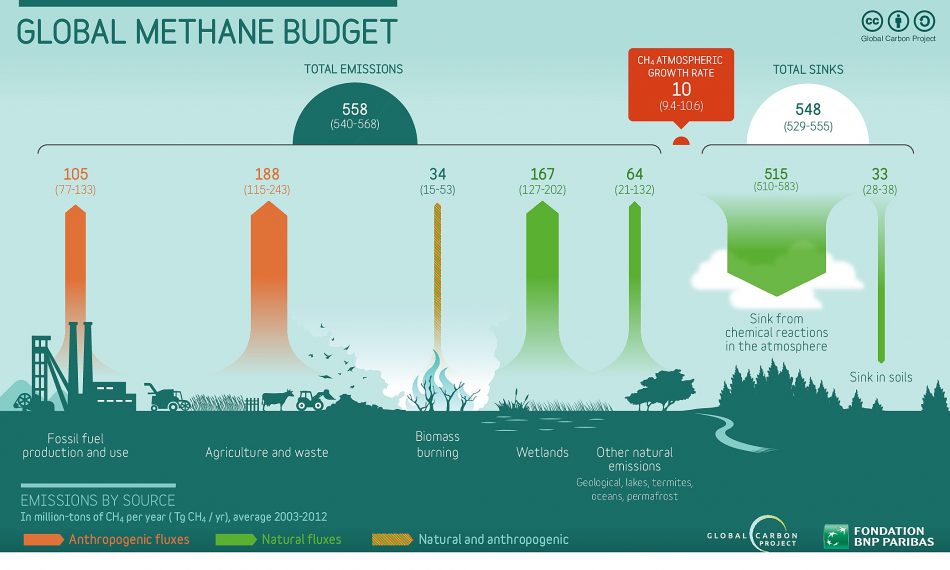
Infographic by the Global Carbon Project used under a creative-commons license.
Nitrous oxide has a greenhouse effect 300 times stronger than that of carbon dioxide and also depletes the ozone layer, allowing more solar radiation in to warm our atmosphere. We emit 3 billion tons of it a year through agriculture, burning fossil fuels and industrial processes.
In 2019, the levels of methane in the atmosphere were 257% higher than pre-industrial levels and nitrous oxide 122% higher.
Accelerating warming
The climate is warming at an accelerating rate as our emissions soar. Since 1993 the rate of oceanic warming has more than doubled, and we are seeing accelerations in sea level rise and retreat of the ice sheets. The combined effect of increasing carbon dioxide, methane and nitrous oxide in the atmosphere are the main driving forces behind the temperature increases we are observing.
According to the IPCC:
“It is extremely likely that more than half of the observed
Intergovernmental Panel on Climate Change (IPCC) 2014 – AR5 Climate Synthesis Report
increase in global average surface temperature from 1951 to
2010 was caused by the anthropogenic increase in GHG concentrations and other anthropogenic forcings together“
Confidence and Uncertainty
If you take a look through the IPCC report or one of the summary documents you’ll notice that it is littered with phrases like “extremely likely” or “moderate confidence”. That’s because although the climate models we have now are extremely sophisticated, they can never be perfect.
To acknowledge that, the IPCC and other scientists report their results according to how much confidence we have that a particular number or statement is correct. They might even include a range – this is known as a ‘confidence interval’ and is usually the range of values within which we are 95% certain the true value actually lies.
Confidence Intervals
This doesn’t mean the science isn’t sound, it’s just that no prediction is ever 100% accurate, and the further into the future or past we try to look, the greater the uncertainty. Our climate models are trying to project many incredibly complex, inter-connected processes occurring simultaneously in the air, soil, and water, so of course there is some degree of uncertainty around these estimates.
As we have done more research and refined our models, our confidence intervals have become smaller and our confidence has grown. The most recent IPCC report is, by definition, based on a larger body of scientific literature than the previous ones.
So the variability between estimates is evidence of scientific rigour, not a lack of consensus. The numbers might vary a little bit, but the take-home message is clear: global temperatures are rising as a result of increasing concentrations of greenhouse gases in the atmosphere, and humans are responsible for most of it.
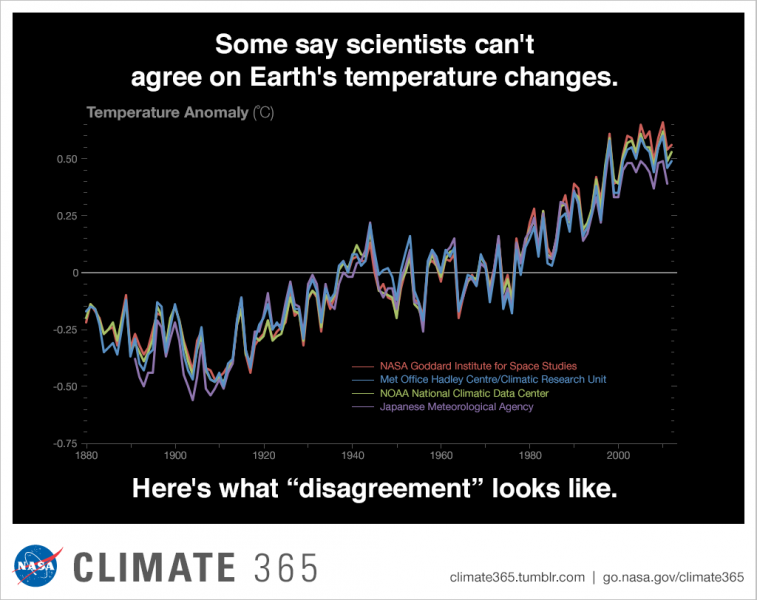
Image from NASA Global Climate Change
Of course the climate is changing, it’s always been changing
The Earth has been through a lot, climate-wise, over the past 4.5 billion years, from bombardment by meteors, through violent periods of volcanic activity, and ferocious ice ages. One of the most striking things about the long-term trend in climate is that it appears to be cyclical. So surely this is just another warming phase in a long-term climate cycle that has nothing to do with humans?
Well, the Earth’s orbit varies naturally according to three cycles known as Milankovitch Cycles – these are responsible for the cycles of climate we see in the geological record. But these cycles repeat themselves over 100,000, 40,000 and 21,000 year timescales – not the 150-year scale we’re talking about.
- Eccentricity – 100,000 year cycles
Our orbit transitions from an almost perfect circle to a thinner ellipse over a period of about 90,000 – 100,000 years. When the orbit is very elliptical, the solar radiation hitting the earth in summer can be 20 – 30 percent higher than in winter, compared to just a 6 percent difference at the moment. Greater eccentricity – a more elliptical orbit – means that the Earth passes closer to the sun in summer, creating hotter summers worldwide. - Obliquity – 40,000 year cycles
The tilt of the Earth is also constantly changing, from 22.1 degrees to 24.5 degrees over a period of about 40,000 – 41,000 years. Obliquity or tilt is the reason we have distinct summers and winters. A larger tilt means stronger seasons – warmer winters and much colder summers.
- Axial precession – 21,000 year cycles
The Earth wobbles slightly on it’s axis as it spins, changing orientation of the tilt through a full 360 °over a period of about 21,000 – 23,000 years. Precession is the reason that the souther hemisphere has more extreme seasons than the northern hemisphere. Precession means that Polaris hasn’t always been the North star, and in about 12,000 years it’ll be Vega. Whichever hemisphere is pointed towards the sun during the closest part of Earth’s orbit will experience more pronounced seasons, while the other hemisphere has less distinct seasons.
Planetary cycles drive ice ages
At times in Earth’s history when its orbit has been quite elliptical and /or its tilt has been small, cool summers allowed ice to build up in high latitudes and the northern hemisphere entered a glacial phase. These phases would start with lower global temperatures and rapidly snowball (forgive the pun) the Earth into an ice age as a result of feedback loops.
During cooler phases, ice began to cover the sea and land, slowing plant and microbial activity to a crawl. This meant the carbon cycle itself slowed down, creating a positive-feedback loop that can kept the Earth locked in an ice age until its orbital cycles naturally warmed the planet again.
During warmer interglacials, the oceans dissolved less CO2, again creating a feedback loop that this time warmed the planet, until the Earth’s orbital cycles brought the planet naturally back into a glacial phase.
This cycle of ice ages and warmer interglacials occurred over tens or hundreds of thousands of years. In the transitions between ice ages and warmer periods, the Earth’s temperature rose by 4°C – 7°C over the space of about 5,000 years. Over the past century, global temperature has risen more than 10 times faster. The Earth hasn’t warmed this fast in 2,000 years.
Couldn’t it be the sun?
For most of Earth’s history, average global temperatures have closely tracked the cyclical changes in solar radiation, caused by changes in the Earth’s orbit and tilt. But orbital changes cannot explain the current warming trend – in fact the World should be cooling right now, not warming. For the last 6,000 years, prior to the start of large-scale deforestation and fossil fuel combustion by humans, the Earth’s climate was gradually cooling, with another glacial phase expected in the next 1500 years.
But then the industrial era arrived, and global temperatures started to depart from the natural cycle of solar radiation. Over the past 150 years, the two lines on the graph have diverged – global temperatures are rising even though solar radiation is actually decreasing.
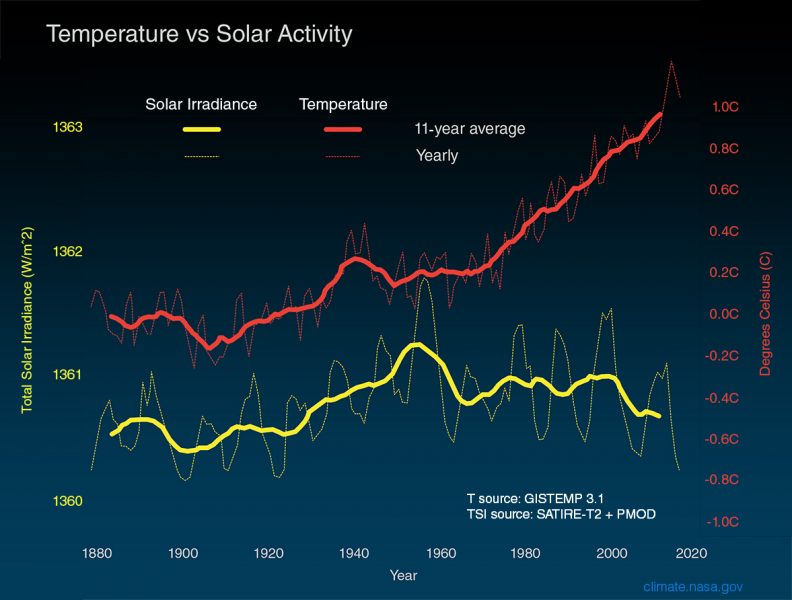
Graph from NASA Global Climate Change
Sunspots are caused by storms on the surface of the sun and can cause solar flares that have a small impact on the climate. Scientists have been monitoring the amount of solar energy hitting the earth continuously since 1978, and there has been no increase that could account for the observed rising temperature.
What about volcanoes?
There are other sources of carbon, of course, such as the movement of tectonic plates and fuming volcanoes. Volcanoes can spew out a plethora of different gases and particles known collectively as ‘aerosols’, and these can have either a heating or cooling effect.
Some aerosols – generally those that are light or translucent in colour such as pure sulfates and nitrates – reflect the sun’s light back into space and have a cooling effect on the global climate. Others – generally darker molecules like carbon – absorb solar radiation and have a warming effect on the atmosphere.
Even the source of a particular aerosol matters – black carbon, produced by high-temperature combustion such as fossil fuels, has a greater heating effect than brown carbon released from burning plant matter.
Most of what is ejected from a volcano is sulphur dioxide, which has a strong cooling effect on the climate, and although they do also release carbon dioxide, it is just a fraction of what humans are emitting. A recent study found that globally, human carbon emissions are 100 times greater than those from volcanoes.
If it’s been this warm before, the what’s the problem?
It is true that there are times in Earth’s history when the climate has been substantially warmer than it is today, and life on Earth has prevailed, although not since humans began roaming the Earth. For example, during the Pleistocene epoch (2.5 million to 11,700 years ago), global temperatures were several degrees warmer than today, forests fringed the Arctic Ocean and Lions roamed what is now Trafalgar square. Looking back further into Earth’s geological history, the Eocene epoch (56 to 33.9 million years ago) was a balmy 10°C hotter than today.
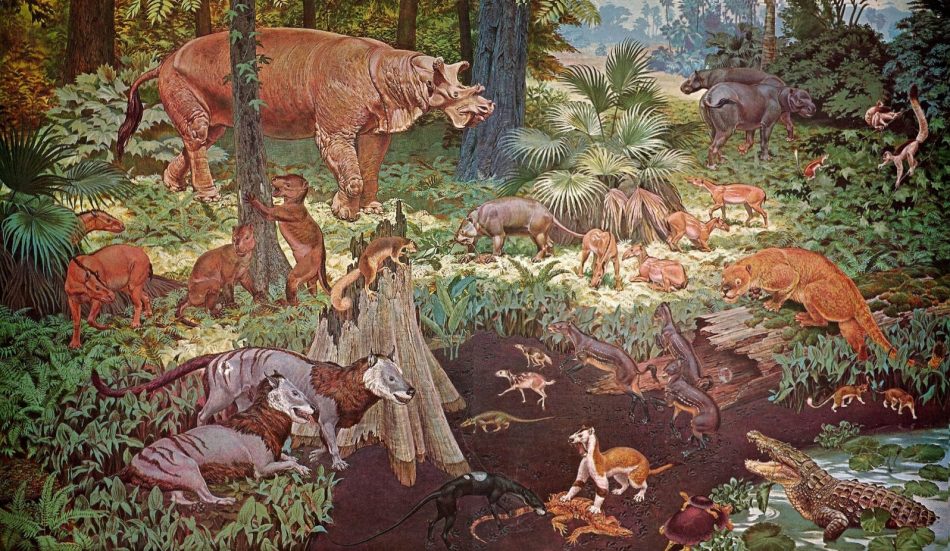
Public domain image from Wikipedia
The key difference with these examples is that life on Earth had millions of years to gradually adapt to the changing climate. Life was able to thrive even in what seem like very inhospitable climates to us.
But there have been a few times in the history of Earth when greenhouse gas emissions and temperature have jumped sharply, as they are doing today, and these led to catastrophic mass extinction events. Just like today.
Rapid climate change spells disaster
In the past, these dramatic shifts were usually driven by massive volcanic eruptions which released thousands of gigatons of CO2 into the atmosphere in a very short space of time. These events are known as ‘large igneous provinces’ but there hasn’t been one for 16 million years. Frankly if one was happening right now, we’d have even bigger problems on our hands.
One example of a large igneous province occurred around 250 million years ago, at the end of the Permian epoch, and it wiped out 90% of all life on Earth. Similar sudden climatic changes in the Triassic and Cambrian periods didn’t turn out much better.
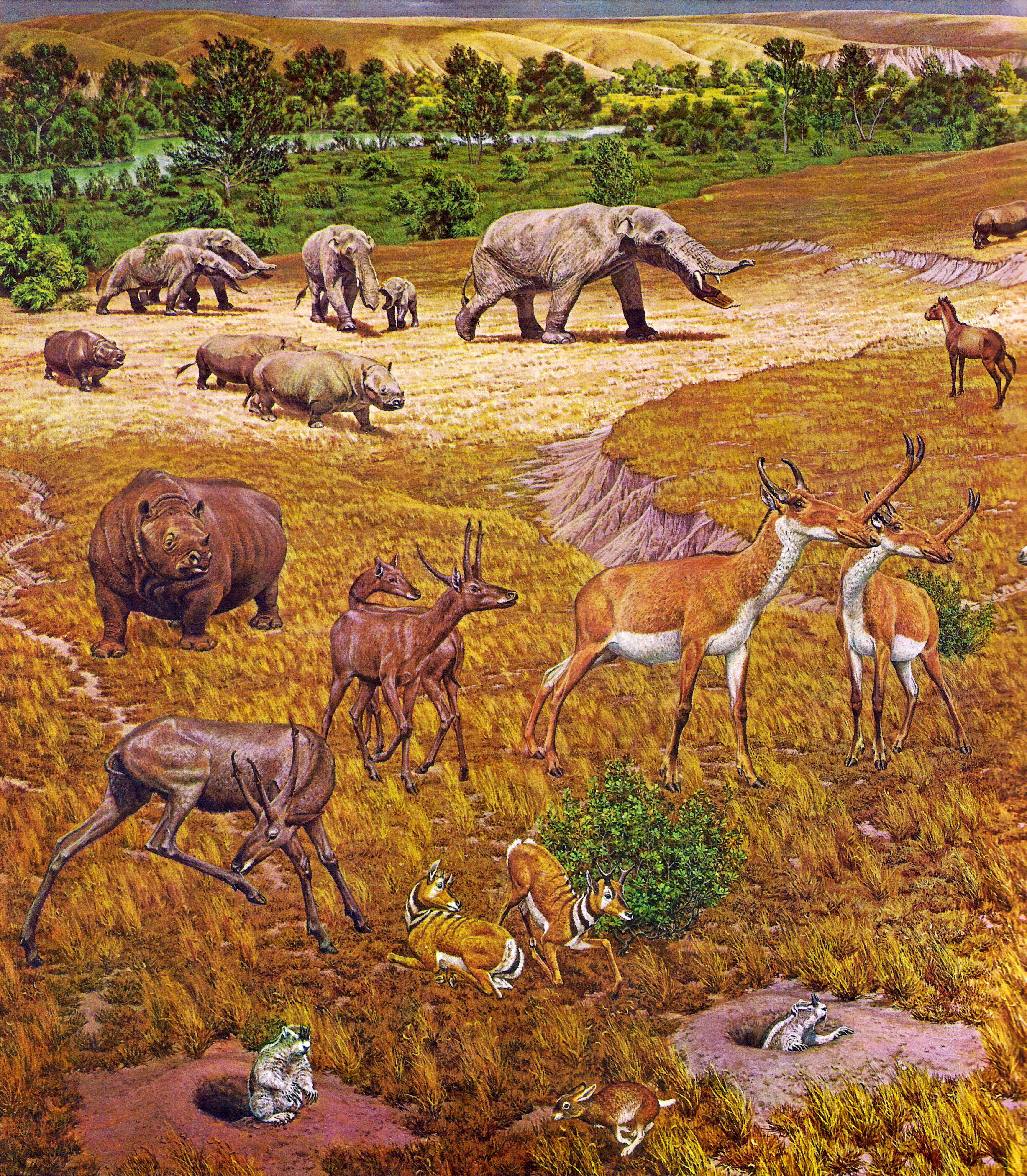
Public Domain Image from Wikipedia
The last time atmospheric CO2 levels were this high was in the middle of the Pliocene epoch, around 3.3 million years ago. Temperatures were about 2 °C warmer than today, but only for short spells. The last time the earth experienced prolonged periods with CO2 levels this high was 16 million years ago, in the middle of the Miocene epoch.
Yale Climate Connections.
The legacy of the little ice age
You might have heard that the current warming trend is just evidence of the planet emerging from the Little Ice Age between 1300 and 1850 AD, when temperatures dropped by up to 2°C, and returning to warmer Medieval conditions. But both the Little Ice Age and the Medieval Warm period were localised events, affecting north-west Europe, eastern North America, Greenland and Iceland. The last time global temperatures were this high was around 7,000 years ago, when temperatures were approximately 0.6°C warmer than the 1961 and 1990 average – similar to today’s climate.
The Little Ice Age was a cold blip in an otherwise fairly warm spell, and it appears that humans may have been behind this sudden climatic change, too. European colonisation of the Americas killed 56 million native people, leaving 55 million hectares of abandoned villages and farmland free to grow over with vegetation. This vegetation absorbed so much carbon dioxide from the atmosphere that you can see the mark in the geological record.
OK, but how do scientists know what will happen in the future?
Scientists have developed highly sophisticated models of the Earth’s climate and weather systems, that allow us to model these processes into the future. These models consider solar radiation, volcanic and tectonic activity, ocean circulation, greenhouse gases and aerosols, cloud cover and precipitation, atmospheric circulation, absorption by trees, soils and oceans, and so on. Each of these processes is modelled based on real-world experiments and is constantly being refined and improved as we gather more information.
The largest unknown in our climate models is how much carbon we will emit over the next 80 years , so the IPCC has generated a range of climate models (known as Representative Concentration Pathways, or RCPs) that consider different future scenarios. They are based on the concentration of CO2 in the atmosphere, and range from RCP 2.6 (low-emissions, lots of mitigation) to RCP 8.5 (high emissions, no mitigation).
These models create a range of possible climate outcomes, but initially they show a surprising amount of inertia – regardless of which emissions scenario you look at, the large effects only start to become apparent by 2030. This is largely because the ocean has such a huge capacity to absorb heat that it takes a while for the effect of elevated CO2 to kick in. But as 2030 draws ever closer, this is little comfort.
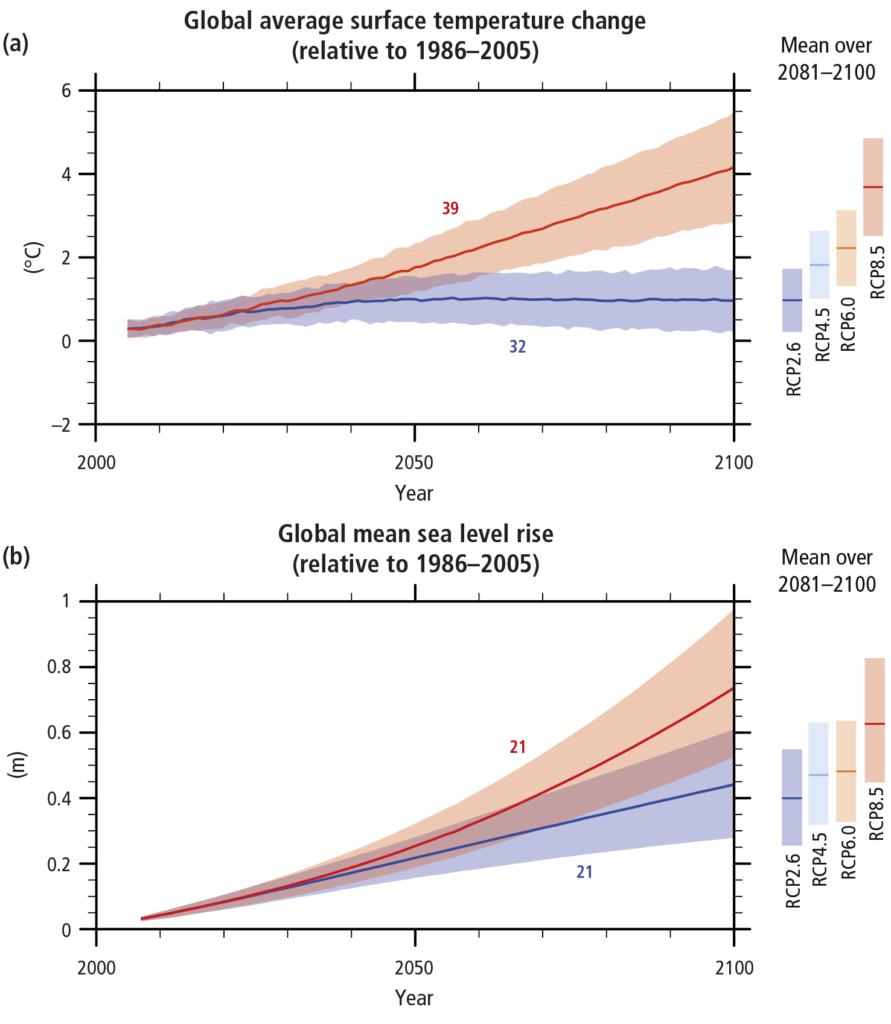
Graph from the IPCC AR5 Summary for Policy Makers (2014)
Climate Feedbacks
Generally, the changes predicted are extensions of current trends – warming will occur most rapidly at the poles, the oceans will warm more slowly than the land, and so on. But there are also some feedback loops that can amplify the rate of change. For example, ice is paler than liquid water and so reflects more solar radiation from the Earth’s surface back into space, but as sea ice, glaciers and permafrost retreat worldwide, we will be able to rely on this effect less and less to cool the planet.
Many scientists believe there are tipping points after which feedback loops will lock us into accelerating climate change that we cannot prevent, even if we reduce our greenhouse gas emissions. For example, melting permafrosts are revealing the carbon-rich peat bogs below, releasing large amounts of greenhouse gases into the atmosphere.
Some people will tell you these are absolute worse case scenarios and the IPCC is being overly pessimistic, but in fact the evidence so far suggests the opposite. We have already seen change far more rapid than predicted, with Oceans rising, Greenland’s ice sheet breaking up, and Arctic summer sea ice receding, faster than expected. If anything, our predictions about the rate of feedback loops and the timing of tipping points have proved optimistic compared to reality.
Video by NASA and the National Snow and Ice Data Center
If the science is sound, why is there so much debate and controversy?
Firstly, our measurements of past climate and our projections of the future are not really single values but ranges (see above note on uncertainty), so some scientific debate around those is totally normal and healthy, and these estimates are constantly being refined as we get new data or add new processes to our models.
The main reason that the debate has raged so fiercely and for so long is that there is a lot of money fuelling it. The five largest publicly-owned oil and gas companies spend roughly USD $200 million a year on lobbying designed to “control, delay or block binding climate-motivated policy”, according to a report by InfluenceMap.
“These companies have mastered the art of corporate doublespeak – by boasting about their climate credentials while quietly using their lobbying firepower to sabotage the implementation of sensible climate policy“
Catherine Howarth, Chief Executive of ShareAction
Staying in budget for 2 degrees
We’re going to run out of fossil fuels sooner or later, but if we continue to burn them until they run out – emitting another 750 billion tonnes of carbon in the process – we will blow past our Paris Climate Accord commitments and commit ourselves to well over 2 degrees of warming.
If our total emissions since the industrial revolution exceed 1,000 gigatons of carbon, that would lock us in to around 2°C increase in global temperatures by 2100, but after that climate feedbacks would spiral the planet towards a 3°C or 4°C increase before things started to stabilise.
To sum up, the evidence for human-caused climate change is unequivocal, and if we don’t act now we are committing ourselves to centuries of climate change beyond our control.
The basic laws of thermodynamics cannot be moved or bent, our only choice now is which trajectory do we want to take?
It amazes me that people who can be so proud of the human species – describing they describe us as the most successful, the most intelligent, the pinnacle of evolution – are somehow unable or unwilling to believe that this great species, all 7.8 billion of us, could possible have enough impact to alter the global climate.
When the first photosynthesising organisms, known as cyanobacteria, evolved some 3.5 billion years ago, they started releasing oxygen into the atmosphere for the first time in Earth’s history. They became so successful that their oxygen emissions fundamentally changed the global atmosphere. In the process, they wiped out 95% of all life on Earth, which had been adapted to a low-oxygen environment.
If single-celled organisms can do it, why not us?
Want to know more?
- Lallanila, Live Science (2018) – What is the Greenhouse Effect?
- NOAA Climate.gov (2019) – Climate Change: Atmospheric Carbon Dioxide
- NOAA (2008) – How we measure background CO2 levels on Mauna Loa.
- NASA Earth Observatory (2011) – Changes in the carbon cycle
- 30-Second Climate (2018)
- Maslin, The Conversation (2015) – Explainer: how scientists know climate change is happening
- Bulletin of the American Meteorological Society (2018) – Explaining extreme events of 2017 from a climate perspective
- Bruckner – Paleoclimatology: How can we infer past climates?
- Centre for Ice and Climate – Past atmospheric composition and greenhouse gases
- Bruckner – Paleoclimatology: How can we infer past climates?
- Munroe (2013) – What Does 400 ppm Look Like?
- Skeptical Science (2014) – Past and Future CO2
- Maslin, The Conversation (2019) – Five climate change science misconceptions – debunked.
- Skeptical Science – Global Warming & Climate Change Myths
- UN Environment Programme (2019) – Temperature rise is ‘locked-in’ for the coming decades in the Arctic
- Carbon Brief (2018) – How do climate models work?
- IPCC (2019) – Special Report: The Ocean and Cryosphere in a Changing Climate
- IPCC (2014) – AR5 Synthesis Report: Climate Change 2014
- World Meteorological Organisation (2019) – United in Science
- Holder, Kommenda and Watts, The Guardian (2017) – The three-degree world: the cities that will be drowned by global warming
If you like graphs and data:
- IPCC Data Distribution Centre – The Observational Record
- Dr. Pieter Tans, NOAA/ESRL and Dr. Ralph Keeling, Scripps Institution of Oceanography. Trends in Atmospheric Carbon Dioxide
- CO2-Earth – Global Warming Update
- NOAA (2018) – Global Climate Report – Annual 2018
- NOAA (2018) – Arctic Report Card 2018
- Richie and Roser, Our World in Data (2019) Fossil Fuels
- Global Carbon Atlas – CO2 Emissions Map
- Global Carbon Project (2019) – Global Energy Growth is Outpacing Decarbonization
The Hard Science:
- Neukom, R., Steiger, N., Gómez-Navarro, J. J., Wang, J., & Werner, J. P. (2019). No evidence for globally coherent warm and cold periods over the preindustrial Common Era. Nature, 571(7766), 550-554.
- Neukom, R., Barboza, L. A., Erb, M. P., Shi, F., Emile-Geay, J., Evans, M. N., … & Schurer, A. (2019). Consistent multi-decadal variability in global temperature reconstructions and simulations over the Common Era. Nature geoscience, 12(8), 643-649.
- Paerl, H. W., Hall, N. S., Hounshell, A. G., Luettich, R. A., Rossignol, K. L., Osburn, C. L., & Bales, J. (2019). Recent increase in catastrophic tropical cyclone flooding in coastal North Carolina, USA: Long-term observations suggest a regime shift. Scientific reports, 9(1), 10620.
- Nerem, R. S., Beckley, B. D., Fasullo, J. T., Hamlington, B. D., Masters, D., & Mitchum, G. T. (2018). Climate-change–driven accelerated sea-level rise detected in the altimeter era. Proceedings of the National Academy of Sciences, 115(9), 2022-2025.
- Zeebe, R. E., Ridgwell, A., & Zachos, J. C. (2016). Anthropogenic carbon release rate unprecedented during the past 66 million years. Nature Geoscience, 9(4), 325.
- Marcott, S. A., Shakun, J. D., Clark, P. U., & Mix, A. C. (2013). A reconstruction of regional and global temperature for the past 11,300 years. science, 339(6124), 1198-1201.
- Dai, A. (2013). Increasing drought under global warming in observations and models. Nature climate change, 3(1), 52.
- Caballero, R., & Huber, M. (2013). State-dependent climate sensitivity in past warm climates and its implications for future climate projections. Proceedings of the National Academy of Sciences, 110(35), 14162-14167.
- Tzedakis, P. C., Channell, J. E., Hodell, D. A., Kleiven, H. F., & Skinner, L. C. (2012). Determining the natural length of the current interglacial. Nature Geoscience, 5(2), 138.
- Shakun, J. D., Clark, P. U., He, F., Marcott, S. A., Mix, A. C., Liu, Z., … & Bard, E. (2012). Global warming preceded by increasing carbon dioxide concentrations during the last deglaciation. Nature, 484(7392), 49.Chicago
- Lacis, A. A., Schmidt, G. A., Rind, D., & Ruedy, R. A. (2010). Atmospheric CO2: Principal control knob governing Earth’s temperature. Science, 330(6002), 356-359.
- Tripati, A. K., Roberts, C. D., & Eagle, R. A. (2009). Coupling of CO2 and ice sheet stability over major climate transitions of the last 20 million years. science, 326(5958), 1394-1397.
- Lüthi, D., Le Floch, M., Bereiter, B., Blunier, T., Barnola, J. M., Siegenthaler, U., … & Stocker, T. F. (2008). High-resolution carbon dioxide concentration record 650,000–800,000 years before present. Nature, 453(7193), 379
Milly, P. C. D., Wetherald, R. T., Dunne, K. A., & Delworth, T. L. (2002). Increasing risk of great floods in a changing climate. Nature, 415(6871), 514. - Zachos, J., Pagani, M., Sloan, L., Thomas, E., & Billups, K. (2001). Trends, rhythms, and aberrations in global climate 65 Ma to present. science, 292(5517), 686-693.
- Keeling, C. D. (1960). The concentration and isotopic abundances of carbon dioxide in the atmosphere. Tellus, 12(2), 200-203
- Foote, E. (1856). ART. XXXI.–Circumstances affecting the Heat of the Sun’s Rays. American Journal of Science and Arts (1820-1879), 22(66), 382
Annual global temperatures from 1850-2017. Image used under a creative commons license from Climate Lab Book.




With all this evidence, one would think you would be able correctly say what the future looks like. Sadly, none have been right. I got a question though. How are we going to run out of fossil fuels if the earth naturally makes them? Oil is made through bacteria. Coal comes from plant decay. We were told in the 1970s that we had reached “Peak oil.” I remember the bumper stickers. Back then it was called Global Cooling. Then it was switched to Global Warming. Both are one narrative each, but Climate Change. Well, you have an infinite amount of narratives. Also, if this is do real why have you been caught in lies? Why did NOAA fabricate data to make it appear the earth was warming faster than it was? Why when a group of scientists took a ship to Antarctica to prove the ice was melting and when they got stuck, why did the media ignore it and the ones that did cover it call it a cruise ship? Why are the biggest pushers for this the worst polluters? Why is this a problem that the government can only save? Why do you use Antarctica as places for testing? No one lives there. No one is able to fact check your claims? How is a world that is covered by .03% of people able to change the environment? Why did Obama’s Clean Air Act end up leaving taxpayers on the hook for 3 billion dollars? One would think it would have the opposite effect if it’s such a good thing. All your claims say well, it hasn’t been like this for this many years. So, what you’re saying is we did have levels like this before when their was no coal plants? Otherwise you would if said there has never been anything like this ever. Why is it that the solution is to give the government all our money? If you only care about the environment, why is the government pushing things like “Climate Change Racism?”
Hi Matt,
Thanks for taking the time to read my post!
Let me address your points one by one:
The reason we are running out of fossil fuels even though they are naturally produced is that fossil fuels take an extraordinarily long time to produce. It takes millennia of high temperatures and pressures to turn the remains of living organisms into crude oil, natural gas or coal. People have been warning that we are running out of fossil fuels for some time, that is true, however part of the reason that ‘peak oil’ keeps moving is that as oil prices go up, reserves that were previously not financially viable to extract have become profitable. Also, as climate change has begun to melt ice sheets, previously inaccessible reserves have come into play. However, this cannot go on forever and we will eventually run out.
Before it became clear that greenhouse gases in the atmosphere were accumulating and the Earth was warming, some scientists warned of global cooling because, based on natural cycles of temperature, we should be heading into an ice age sometime soon. The fact that we aren’t, and instead we are experiencing accelerating warming, is evidence that humans have disrupted the natural, long-term cycles of global temperature that have existed for millenia.
As I said in my post, there have been times in Earth’s history when it has been this warm, and when greenhouse gases in the atmosphere have been this high, but it has been millions of years since those conditions last occurred. In some cases, scientists make the statement that conditions like this haven’t been seen in at least X number of years – in these cases it may simply be that that is when our records go back to! Furthermore, on those occasions when conditions have changed this rapidly, mass extinctions have occurred. I’m not saying the Earth can’t survive the climate change humans are causing, but it’s quite possible that most life on Earth cannot – humans included.
I don’t know what evidence you are referring to that NOAA fabricated data, that is quite an allegation – please can you share your sources?
I’m afraid I don’t know what you mean about the ship in Antartica, or the suggestion that those who pollute the most are advocating for climate change more strongly. Again, could you please elaborate / share your sources?
I don’t believe that governments will be the only players in addressing the climate emergency, but they have an important part to play. History has shown that without adequate regulation, some companies will always put profit over environmental sustainability. At present, many governments worldwide have policies that actively incentivise continued fossil fuel use even when renewable technologies have become cheaper.
Antartica is an excellent place for gathering scientific data for many reasons – it holds an extensive record of past climate in the ice, it is a temperature-sensitive ecosystem that can act as an early warning about significant changes in global climate, and it is, in many ways, relatively untouched by humans. However, evidence for climate change has and is being collected worldwide – in temperate regions and tropical, in forests and savannahs, on islands and deep within continents.
I don’t find the argument that there are two few humans to affect climate convincing at all, there are over 7 billion of us and we inhabit every continent of the globe. As I discussed in my blog, “How much land on Earth is inhabited”, humans have impacted the vast majority of the world. Not to mention that we have compelling evidence from multiple independent sources that the climate is changing as a result of human activities.
I can’t comment specifically on US politics, but sometimes technology that will result in a vast improvement in the long term requires a short-term investment.
As I said in my post, there have been times in Earth’s history when it has been this warm, and when greenhouse gases in the atmosphere have been this high, but it has been millions of years since those conditions last occurred. In some cases, scientists make the statement that conditions like this haven’t been seen in at least X number of years – in these cases it may simply be that that is when our records go back to! Furthermore, on those occasions when conditions have changed this rapidly, mass extinctions have occurred. I’m not saying the Earth can’t survive the climate change humans are causing, but it’s quite possible that most life on Earth cannot – humans included.